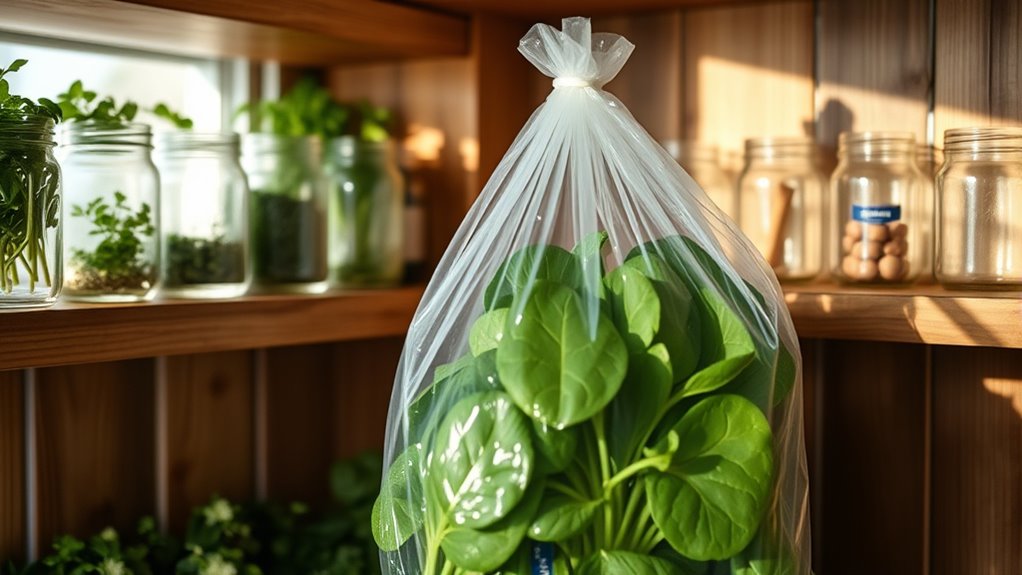To keep spinach fresh longer, store it in the crisper drawer of your fridge at 32°F to 40°F. Use airtight containers or eco-friendly bags to prevent moisture buildup, and always dry the leaves before storage. Place paper towels in containers to absorb excess moisture, and avoid storing it near strong-smelling foods. Regularly inspect the spinach and remove any bad leaves. Follow these tips, and discover even more methods to extend its shelf life.
Key Takeaways
- Store spinach in the crisper drawer of the refrigerator to maintain optimal humidity levels and freshness.
- Use airtight containers or eco-friendly silicone bags to prevent moisture and air exposure.
- Dry spinach leaves thoroughly before storage to reduce excess moisture that can cause decay.
- Regularly inspect for and remove any bad leaves to prevent spoilage of the entire batch.
- For long-term storage, consider blanching and freezing spinach in Ziploc bags to preserve nutrients.
Understanding Spinach Shelf Life
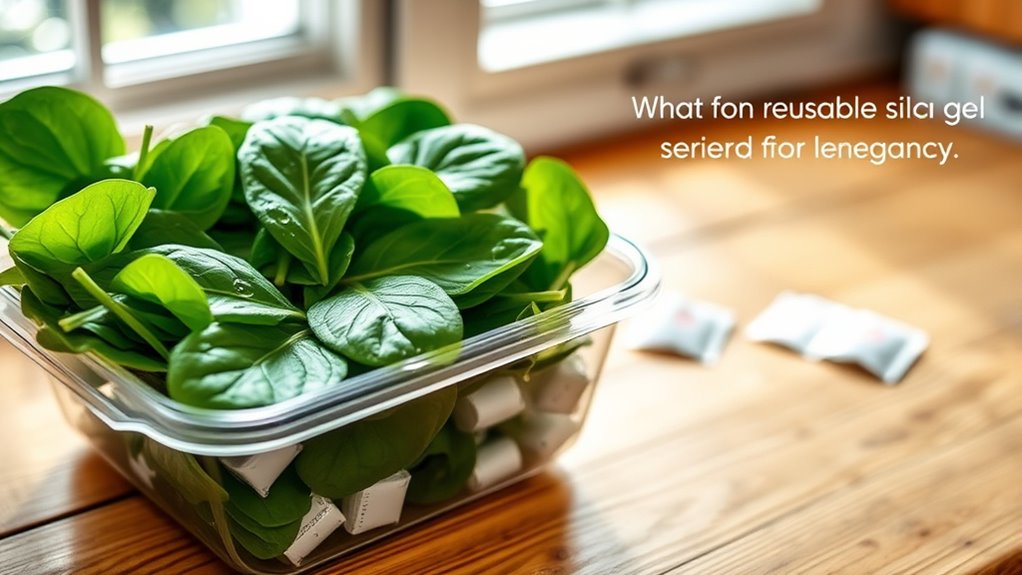
Understanding the shelf life of spinach is crucial if you want to keep it fresh and nutritious for as long as possible. Several factors influence how long your spinach lasts.
Temperature plays a significant role, so make sure to store it consistently in the fridge. Humidity levels should remain moderate to prevent sogginess, and proper packaging must protect spinach from air and moisture.
When you buy spinach, its freshness at purchase directly impacts its overall longevity. Whole leaves generally last 5-7 days in unopened bags, while opened bags last 3-5 days.
Always remove bad leaves to prevent spoilage from spreading, and handle your spinach gently to maintain its condition for maximum shelf life.
Importance of Moisture Control
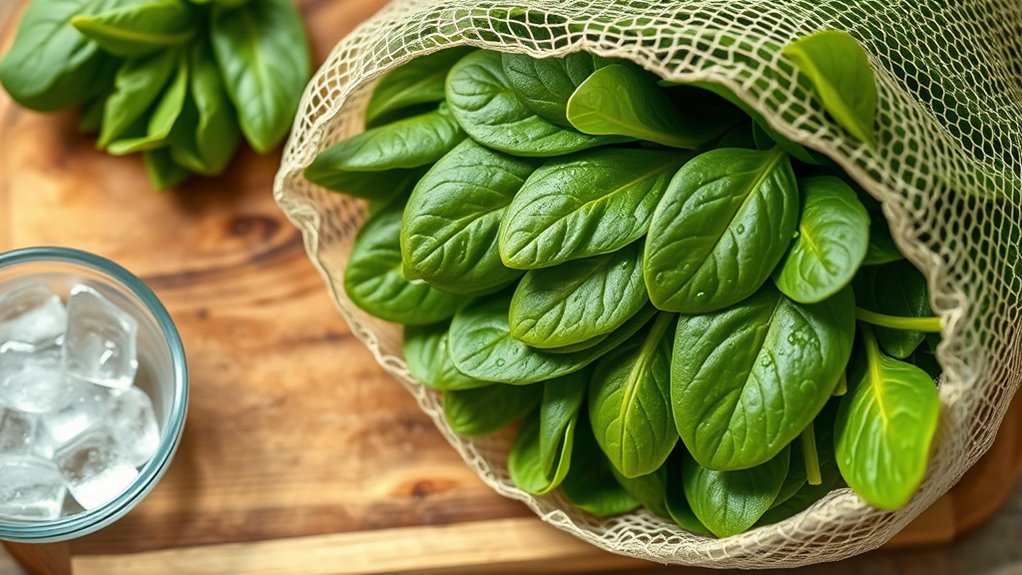
While storing spinach, controlling moisture is vital for maintaining its freshness and preventing spoilage. Excess moisture accelerates decay and encourages bacterial growth, so it's important to dry your spinach leaves using a salad spinner or towels before storage.
To create an optimal environment, you can place paper towels in your storage containers; they'll absorb any excess moisture while maintaining humidity levels around 95-100%. This balance helps keep your spinach crisp without causing dehydration.
Additionally, ensure good air circulation around your containers, and consider using breathable materials to minimize moisture buildup. Regularly check for any signs of moisture accumulation, as this is key to prolonging the life of your spinach.
Choosing the Right Storage Containers
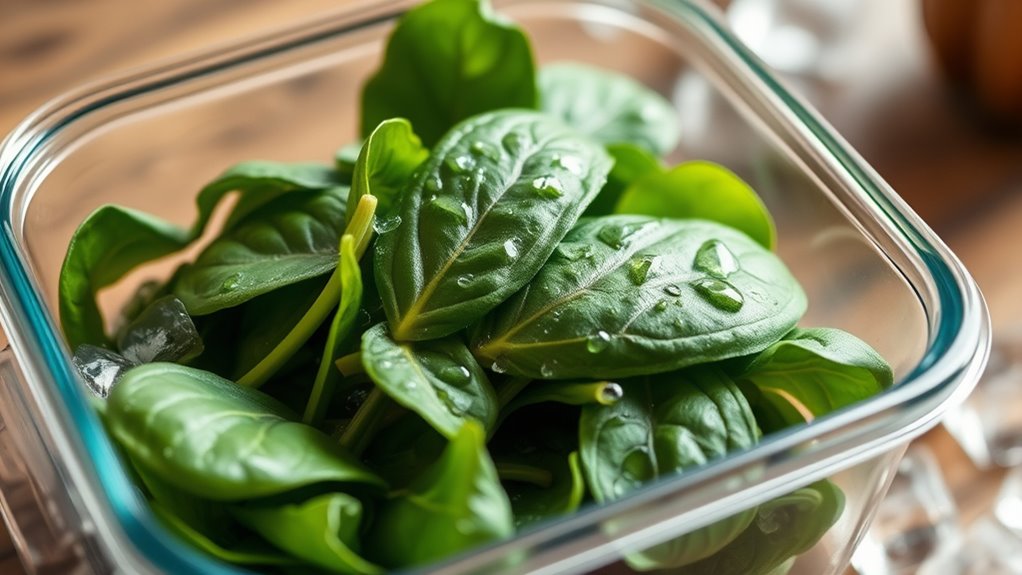
Choosing the right storage containers can significantly impact the freshness of your spinach and other leafy greens. Airtight containers are a great option, as they prevent moisture and air from entering, keeping your greens fresh longer.
Consider eco-friendly alternatives like silicone bags, which are dishwasher safe and versatile for both fridge and freezer storage. You might also try produce keepers, designed with vents and trays to control moisture levels, ideal for maintaining freshness over extended periods.
For a more sustainable choice, reusable bags can be used multiple times, reducing plastic waste while effectively storing your spinach. Explore these options to find what works best for you, ensuring your leafy greens stay crisp and tasty.
Proper Refrigeration Techniques
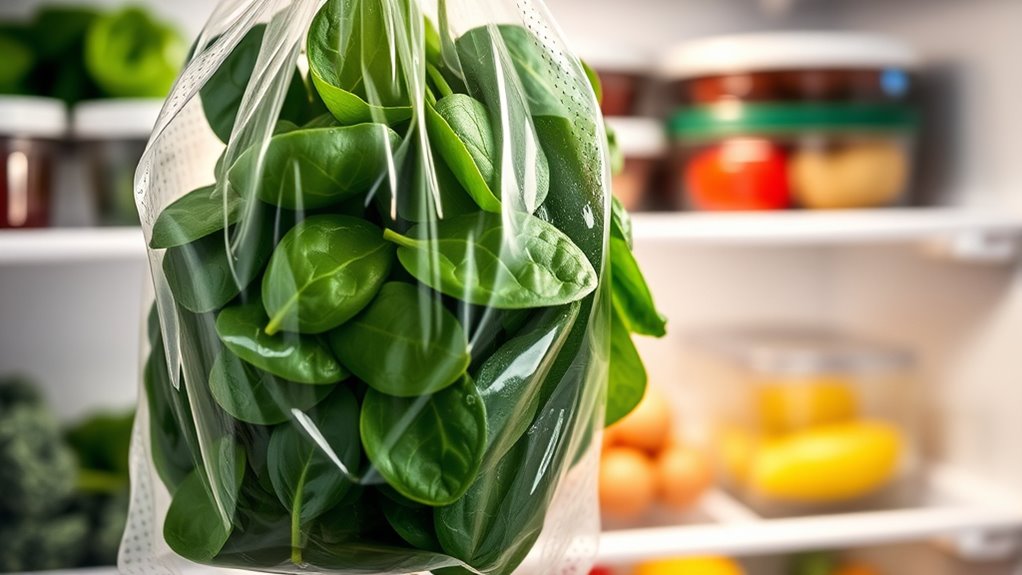
Storing spinach properly in the refrigerator plays a key role in keeping it fresh and flavorful.
Keep your spinach in the crisper drawer, where humidity levels are ideal for leafy greens. Ensure the refrigerator temperature is set between 32°F and 40°F, maintaining a consistent environment.
Avoid overcrowding the spinach; it needs space to breathe and to prevent moisture buildup, which can cause spoilage. Store it away from direct cold air vents to prevent drying out.
Also, keep spinach away from strong-smelling foods to avoid odor absorption. Regularly inspect your spinach for signs of spoilage, and remember that with proper refrigeration, its shelf life can extend to 3-7 days.
Tips for Handling Fresh Spinach

When handling fresh spinach, it's essential to give it a thorough inspection to ensure you're only storing the best leaves. Look for any yellow or brown discoloration and discard wilted or rotting leaves. Check for holes or mold; damaged leaves can lead to spoilage, so remove them promptly.
Remember, you want to store only fresh, vibrant leaves.
Wash spinach just before using it to maintain its freshness, using cool water to prevent wilting. Dry it thoroughly, ideally with a salad spinner, as excess moisture can accelerate spoilage.
If you're not using the spinach right away, it's best to store it unwashed. Keeping these tips in mind will help you enjoy fresh spinach for longer!
Utilizing Paper Towels for Freshness
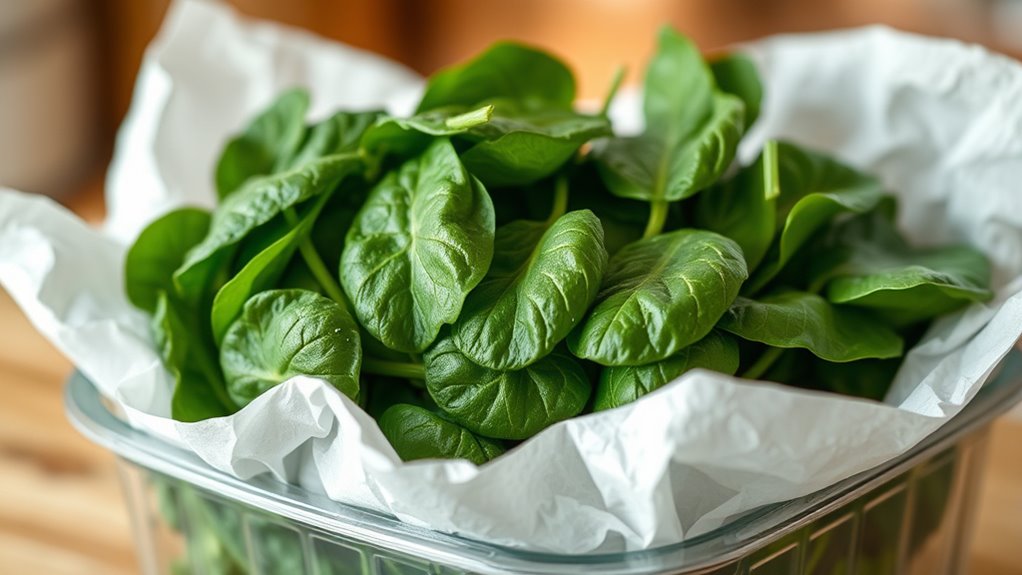
To keep your spinach fresh and crisp, utilizing paper towels is an effective method.
Start by placing a layer of paper towels at the bottom of an airtight container. This absorbs excess moisture, preventing sogginess and spoilage.
Layer your spinach on top, then add another paper towel on top to maintain dryness. Regularly check the paper towels, replacing them when they become damp to ensure optimal conditions.
This simple technique can extend the freshness of your spinach for up to a month, although it typically lasts about a week to ten days.
Not only does this method work well for spinach, but it's also versatile enough for other leafy greens and vegetables, making it a smart choice for your kitchen.
Techniques for Freezing Spinach

Freezing spinach is a fantastic way to preserve its freshness and nutritional value. Start by washing and thoroughly drying the leaves to prevent ice crystals. You can freeze whole leaves for a quick option, or consider pureeing them if you plan to use spinach in smoothies and sauces.
Blanching is recommended to retain color and nutrients, but if you'll use the spinach within six months, it's not necessary. Use Ziploc freezer bags to store your spinach, making sure to remove excess air to prevent freezer burn.
For pureed spinach, freeze in ice cube trays for easy portioning. Properly frozen spinach can last up to a year, making it a convenient choice for your meals!
Innovative Methods to Extend Shelf Life
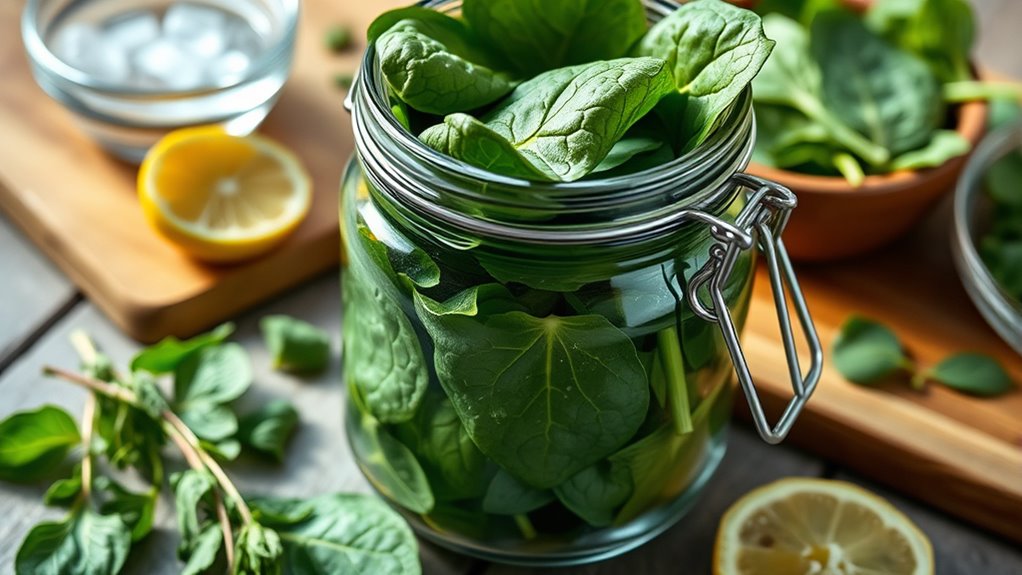
While traditional storage methods are effective, exploring innovative techniques can significantly extend the shelf life of spinach.
Start by using breathable containers with ventilation holes to promote airflow and prevent moisture buildup. Adding paper towels inside can absorb excess moisture, keeping your spinach crisp.
Consider modified atmosphere packaging (MAP) to maintain optimal gas levels. Always store your spinach in the crisper drawer at a consistent refrigerator temperature for best results.
Utilize modified atmosphere packaging and store spinach in the crisper drawer to ensure freshness and optimal gas levels.
If you want to experiment, try vacuum packing or using bamboo baskets for natural airflow.
Don't forget to remove damaged leaves before storage, and avoid washing spinach until you're ready to use it to prevent moisture issues.
These methods can help keep your spinach fresh and flavorful longer!
Monitoring and Maintaining Spinach Quality
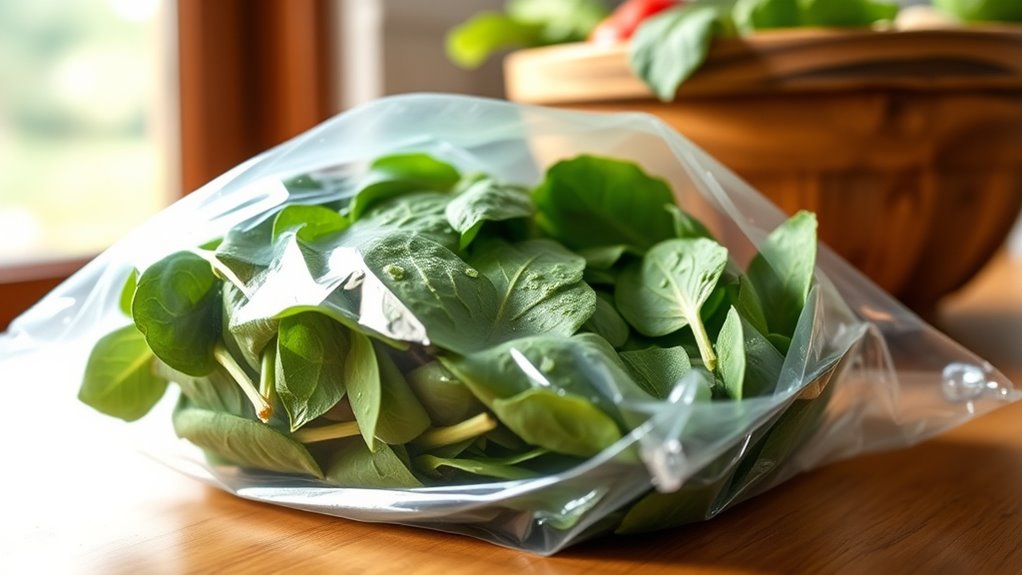
Storing spinach properly is just the first step; keeping an eye on its quality is vital for enjoying its freshness and flavor.
Monitor quality by checking color, texture, and moisture. Non-destructive techniques like near-infrared (NIR) spectroscopy can provide real-time assessments of spinach without damaging the leaves. This technology helps you evaluate freshness and pigment content effectively.
You can also use sensory analysis to assess appearance and smell. Remember, the conditions matter; temperature and humidity levels significantly affect quality.
For best results, store spinach in breathable containers in the refrigerator's crisper drawer. Keeping an eye on these factors ensures you enjoy your spinach at its peak freshness!
Frequently Asked Questions
Can I Store Spinach at Room Temperature?
You shouldn't store spinach at room temperature.
Doing so leads to moisture accumulation, wilting, and nutrient loss, making it spoil faster. The warmer environment speeds up the degradation of vitamins and can cause the leaves to yellow.
If you want to keep your spinach fresh, it's best to refrigerate it in breathable containers.
This way, you'll preserve its quality and enjoy its nutrients for a longer time.
How Can I Tell if Spinach Is Spoiled?
To tell if your spinach is spoiled, start with a visual inspection; it should be bright green.
Check the texture—fresh spinach is tender and perky, not slimy.
Smell it; if there's a musty or sour odor, it's time to toss it.
Look for wilted or soft leaves, and any visible mold means it's spoiled.
If you notice yellow spots or excessive moisture, it's best to discard the spinach to avoid any health risks.
Is It Safe to Eat Wilted Spinach?
Wilted spinach can seem like a culinary disaster, yet it may still be safe to eat, unlike slimy spinach, which poses a significant health risk.
You should inspect your spinach for any discoloration or unpleasant smells. If it's merely wilted, soaking it in ice water can refresh its texture.
However, if it's slimy, it's best to toss it. Trust your senses, and when in doubt, prioritize your health over waste.
Can I Store Spinach With Other Vegetables?
You can store spinach with other vegetables, but be careful.
Keep it away from ethylene-producing veggies like apples and bananas, as they can cause spinach to spoil faster. It's best to group spinach with other leafy greens that thrive in similar conditions.
Additionally, avoid strong-smelling vegetables nearby to prevent flavor transfer.
For optimal freshness, monitor the humidity levels and adjust storage accordingly to maintain the best environment for your spinach.
How Do I Thaw Frozen Spinach Properly?
To thaw frozen spinach properly, you've got a few options.
You can place it in the refrigerator overnight for a slow, safe thaw, or leave it at room temperature in a bowl to let excess water drain.
If you need it fast, use the microwave's defrost setting, or run warm water over it in a strainer.
Just remember to squeeze out extra moisture before using it in your dishes. Enjoy!
Conclusion
By following these simple storage techniques, you can enjoy fresh spinach for longer, transforming your meals from dull to vibrant. While wilting leaves may signal the end, proper care can extend its life and flavor. Embrace the contrast between fresh and spoiled, and take charge of your greens. With just a little effort, your spinach can stay crisp and delicious, elevating your dishes and reducing waste. So, why settle for less when freshness is just a few steps away?

